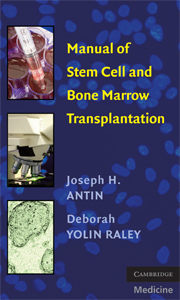Book contents
- Frontmatter
- Contents
- Acknowledgments
- Manual of Stem Cell and Bone Marrow Transplantation
- 1 Rationale for Transplantation
- 2 Types of Transplantation
- 3 HLA Matching in Allogeneic Transplantation
- 4 Stem Cell Source
- 5 Pretransplant Evaluation and Counseling of Patient and Donor
- 6 Conditioning Regimens
- 7 Stem Cell Infusion
- 8 ABO Compatibility
- 9 Engraftment
- 10 Preventative Care
- 11 Transplant-Related Complications
- 12 Graft-Versus-Host Disease – Prophylaxis and Acute
- 13 Graft-Versus-Host Disease – Chronic
- 14 Engraftment Syndrome
- 15 Infectious Disease
- 16 Graft Rejection And Failure
- 17 Gastrointestinal Complications
- 18 Pulmonary Complications
- 19 Veno-Occlusive Disease
- 20 Special Transfusion-Related Situations
- 21 Cardiovascular Complications
- 22 Neurologic Complications
- 23 Cystitis
- 24 Donor Lymphocyte Infusion
- 25 Transplantation: Regulation And Accreditation
- Appendix
- Index
15 - Infectious Disease
Published online by Cambridge University Press: 23 November 2009
- Frontmatter
- Contents
- Acknowledgments
- Manual of Stem Cell and Bone Marrow Transplantation
- 1 Rationale for Transplantation
- 2 Types of Transplantation
- 3 HLA Matching in Allogeneic Transplantation
- 4 Stem Cell Source
- 5 Pretransplant Evaluation and Counseling of Patient and Donor
- 6 Conditioning Regimens
- 7 Stem Cell Infusion
- 8 ABO Compatibility
- 9 Engraftment
- 10 Preventative Care
- 11 Transplant-Related Complications
- 12 Graft-Versus-Host Disease – Prophylaxis and Acute
- 13 Graft-Versus-Host Disease – Chronic
- 14 Engraftment Syndrome
- 15 Infectious Disease
- 16 Graft Rejection And Failure
- 17 Gastrointestinal Complications
- 18 Pulmonary Complications
- 19 Veno-Occlusive Disease
- 20 Special Transfusion-Related Situations
- 21 Cardiovascular Complications
- 22 Neurologic Complications
- 23 Cystitis
- 24 Donor Lymphocyte Infusion
- 25 Transplantation: Regulation And Accreditation
- Appendix
- Index
Summary
Risk factors for infection include the degree and duration of neutropenia; profound pan-immunosupression; disruption of mucosal barrier by radiochemotherapy; HLA mismatch; central venous access; and donor infectious states. Inadequate immunoglobulin (Ig) G2 and IgG4 production increases risk of infection with encapsulated organisms despite total Ig levels in the normal range post transplant.
Please see Chapter 18 for specific pulmonary infections.
GENERAL TIME FRAMES OF WHEN INFECTION IS LIKELY TO OCCUR
Day 0 to 30: Infections related to conditioning regimen and neutropenia (bacteremias of gastrointestinal or catheter-related origin), invasive aspergillosis related to neutropenia, candidemia.
Day 30 to 80: Classic opportunistic infections (Cytomegalovirus [CMV], Pneumocystis jiroveci pneumonia [PCP], toxoplasmosis, nocardiosis, invasive aspergillosis, and other invasive mold infections related to severe GVHD).
Day 180+: Encapsulated organisms (especially in patients with chronic GVHD [cGVHD]), Varicella zoster virus [VZV], PCP. Risk for viral and fungal infections protracted in unrelated donor HSCT.
Figure 15.1 outlines the period of the major host deficits and infections that occur during allogeneic HSCT in relation to when targeted pathogen-specific prophylactic, preemptive, and empiric therapies are deployed. Risk for infectious complications is temporally dependent and significantly decreased in the setting of prophylactic, preemptive, or empiric therapy. The risk of certain infections after transplantation is highly associated with ongoing immunologic manipulation as seen with the therapy for GVHD (linkages noted by vertical arrows).
- Type
- Chapter
- Information
- Manual of Stem Cell and Bone Marrow Transplantation , pp. 100 - 119Publisher: Cambridge University PressPrint publication year: 2009
- 1
- Cited by



